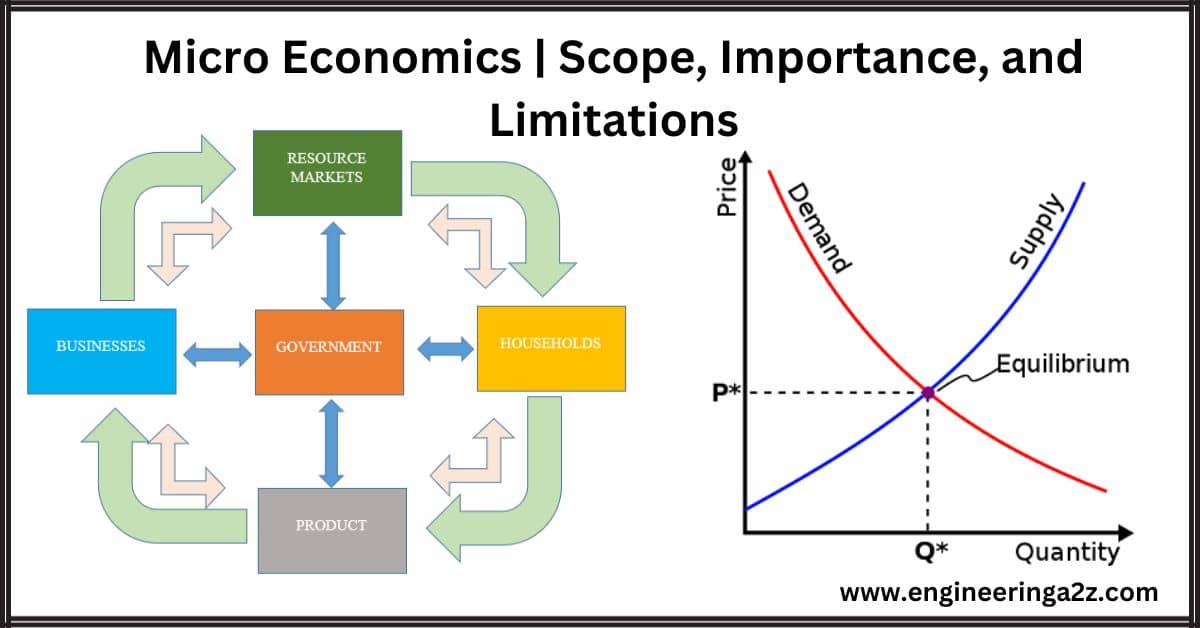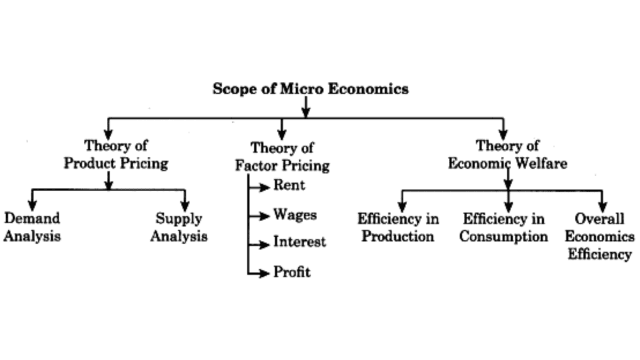
Table of Contents
Introduction
The term Micro has been borrowed from the Greek word, ‘Mikros‘ meaning small. However, it may not be misunderstood that microeconomics refers to small or insignificant economics. As a matter of fact, microeconomics is as essential as macroeconomics. According to Bilas, “The term micro in economics means division into small parts of such economic variables as consumption, investment, saving, etc.”
Under Micro economics, we study individual units, like, as a consumer, a firm, an industry, the price determination of a particular commodity, etc. We also study ‘group’ in it. For example, the market demand curve, which is the aggregate of individual demand curves, is also a subject of study in microeconomics. Still, we do not study in large or national-level groups. Composition and allocation of total production fall under the scope of micro-economics study, whereas under macro-economics we study the level of aggregate production.
Definitions
- Watson says, “Micro economics is the theory of the small, of the behavior of the consumer’s producers and markets.
- In the words of Shapiro, Micro economics deals with small parts of the economy.”
- According to Leftwitch, “Micro economics is concerned with the economic activities of economic units as consumers, resource owners, and business firms.”
- According to Boulding, “Micro economics is the study of a particular firm, particular household individual price, wage, income, industry, and particular commodity”
Scope of Micro Economics
Micro economics deals with the allocation of resources for the achievement of different ends. discusses the following problems:

(1) Theory of Demand: It studies how the demand for a commodity is determined and what the law of demand is. The theory of Demand refers to the demand of the consumer and his maximum satisfaction. It studies how a consumer distributes his limited income on the purchase of different goods at different prices so as to get maximum satisfaction.
(2) Theory of Production: It also studies the theory relating to the production of goods. A firm carries out production with the help of factors of production. Under Theory of Production one studies production function and the laws governing production of goods.
(3) Theory of Price Determination: Micro economics also deals with the theory of price determination. Besides analyzing the conditions of demand and supply, the theory of price determination seeks to explain how the price of goods produced under different market conditions, such as perfect market, monopoly, etc. is determined. Condition of demand and supply are also studied in this theory
(4) Theory of Factor Pricing: Income received by the sale of goods produced with the help of different factors of production, is distributed among these very factors in the form of factor-price, viz., ren wages, interest, and profit. How the price (remuneration) of each factor of production is determined is the problem that deals with the distribution of income and so is studied under micro economics.
(5) Optimum Allocation of Resources: Micro economics is also concerned with the optimum allocation of resources, that is, how efficiently resources are distributed among consumers and producers. A consumer or a firm is in equilibrium when there is optimum allocation of resources Micro-economics therefore studies the conditions necessary for achieving equilibrium.
(6) Welfare Economics: Micro economics also studies welfare economics. Welfare economics spells out an ideal economy. It deals with the welfare of the people as consumers and producers.
Importance of Micro-Economics
The importance of the study of economics lies in the following:
(1) Operation of an Economy: Micro economics explains the functioning of an economy. tells whether different constituents of the economy, namely, consumers, firms, etc., are functioning efficiently or not. According to Watson, “Microeconomics has many uses. The greatest of these is the understanding of the operation of the economy.”
(2) Prediction: Predictions are made on the basis of the theories of micro economics. Predictions are always based on certain conditions, e.g. if a cause occurs then a set of results will follow. For instance, if demand increases prices are also likely to rise.
(3) Economic Policies: The study of microeconomics helps in the formulation of economic policies We can analyze those policies which influence an economy. We can also find out the effect of government policies on the allocation of resources.
4) Economic Welfare: It informs us of the conditions of economic welfare. It is the main subject of normative economics. The study of microeconomics suggests how the ideal of economic welfare can be achieved.
(5) Managerial decision: Business firms make use of microeconomics to make managerial decisions. They make these decisions on the basis of cost and demand analysis.
Limitations of Micro-Economics
The following are the main limitations of microeconomics:
(1) Static: In the study of microeconomics, mostly static analysis is made use of. In it, many economic variables are assumed to be constant. This part of economics is, therefore, unrealistic to a large extent.
(2) Wrong Conclusions: The conclusions drawn from the study of microeconomics are in many cases not valid from the point of view of macroeconomics. For instance, in micro-economics, we say that saving is a virtue so far as an individual is concerned but if it is viewed from a macro angle, that is, if the entire population begins to save more than before, then there will be a fall in aggregate demand for consumption goods leading to fall in production and employment In other words, it will cause misery in the economy. Thus, what is individually a virtue may become socially a vice.
(3) Unrealistic Assumptions: This economic analysis is based on many unrealistic assumptions like the prevalence of full employment and perfect competition in the economy. In real life, these are not found.
(4) Limited Scope: Micro-economics has limited scope, the study of many important economic policies and problems like, fiscal policy, monetary policy, inflation, unemployment, etc. is outside its scope. In short. Bilas has rightly said, “While price theory is useful, one should not be blinded by the theory. It is simply a tool of analysis for the economists to go along with other tools such as history, statistical methods, and mathematics.”
Frequently Asked Questions (FAQs)
-
What is Microeconomics?
Microeconomics is a branch of economics that focuses on individual economic agents like consumers, firms, and markets, analyzing their behaviors, decisions, and interactions in relation to resource allocation, pricing, and production.
-
Who is the father of Microeconomics?
The father of microeconomics is considered to be Alfred Marshall, a British economist known for his pioneering work on supply and demand theory.
-
Why is Microeconomics called?
Microeconomics is named so because it examines economic activities at a small-scale or micro-level, focusing on individual choices, markets, and agents, rather than the entire economy as in macroeconomics.
-
What are the 3 main concepts of microeconomics?
Three main concepts in microeconomics are:
1. Supply and Demand: Examining how prices and quantities are determined in markets.
2. Utility and Preferences: Analyzing consumer choices and satisfaction.
3. Costs and Production: Understanding firms’ cost structures and production decisions.
Related Posts
- Comparison Between Microeconomics and Macroeconomics
- B.Tech – Electrical Engineering Previous Year Question Papers Download
- Economics For Engineers Book PDF
- Globalisation | Impacts of Globalisation
- Supply : Law of Supply
- Markets: Perfect competition, Monopoly, Monopolistic & Oligopoly

















Leave a Reply